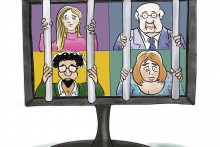In the past year, we have proven that we can work and communicate (only) digitally. We videocall, we discuss, we get the job done. So what doesn’t get across the internet connection? ‘If we think of communication, we think of talking,’ says Arbo Unie occupational consultant Suzanne Tijssen. ‘The words we say are still the same, but words are just a small part of communication. Seeing, feeling and connecting with each other emotionally, seeing what the others are doing, their eyes, the complete picture: that is what communication is about. This biggest part of communication is lost in the digital world.’
Social presence
We need more than high resolution picture and sound quality to compensate for the lack of social cues, adds Jan van Erp, UT professor of Tangible User Interaction. ‘We can see each other, hear each other, but in real life we have much more sensory modalities that we use to communicate than only vision and audition. People nowadays talk of skin hunger, our inherited longing for human touch, but it is about more than that. When talking online, we only see each other’s head and shoulders. We miss a lot of body language which we’d normally have if we were sitting in the same room. Because of that, we don’t really feel socially present. Although we are communicating, I don’t feel that you are socially close to me. Which would become even more difficult if more people join the meeting.’
'We can see each other, hear each other, but in real life we have much more sensory modalities'
‘Especially the group conversations are really difficult now,’ agrees Alexander van Deursen, UT professor of Communication Science. ‘Being in a group chat or talking to someone online can never replace face to face communication. Yes, digital meetings are mostly faster and more efficient, but the feeling of presence is much larger in personal meetings, the feeling that you matter and that people value what you say. That is also one of the reasons why the digital meetings don’t last as long - people are less inclined to raise their hands. People have to unmute, raise their hands and be asked to speak. The threshold is much larger.’

Extra energy
Gertrude Agterhuis, Arbo Unie occupational consultant who regularly works at the UT, sees another possible reason why our online gatherings tend to be shorter – and more intense. ‘In online meetings we plan the things we want to say, we use the agenda and we are very straightforward. Meanwhile we are disturbed by a lot of things: seeing yourself on camera, looking at small faces, observing emotional reactions - it’s very tiring to really see what is going on. As social beings, we want to connect but it can be a burden to do this online. This takes a lot of extra energy.’
The constant use of technology has not only led to new patterns of communication, but for many people it has also caused feelings of social and professional isolation, warns Alexander van Deursen. ‘The social isolation can be really strong and it negatively impacts our wellbeing. Even if you do your work more effectively, your wellbeing might decline. This is of course very personal, but in general a lot of people struggle. Feeling disconnected brings on a lot of uncertainties; and people’s wellbeing partly depends on uncertainty reduction.’
Lost relationships
This disconnect can stem from overall changes in work duties, as many jobs undergo a major transformation due to the pandemic, but there seems to be one underlying issue: the aforementioned lack of social presence. As Susanne Tijssen points out, according to the self-determination theory, a theory of human motivation and personality, all human beings are driven by three basic psychological needs: autonomy (the need to feel ownership of one's behavior), competence (the need to grow and develop), and relatedness (the need to feel connected to others).
‘And it is the last aspect – relationships - that has drastically changed recently,’ thinks Tijssen. ‘Some people are very happy with the current situation, but most people really miss their colleagues. They get energy from other people. The main issue is losing connection with other people.’ How to fix that? ‘That is a big question,’ adds Tijssen. ‘Maybe it starts with realizing that the current situation isn’t optimal for everyone and needs to be addressed.’
‘There is a major difference between working from home and being forced to be at home while trying to work’
Professor Van Deursen doesn’t see a solution to the issue either, at least not as long as the lockdown continues. ‘The main thing that influenced how we communicate is having to work from home. The enforcement to work from home applies to everybody. That is completely different from the situation we had prior to corona, because then working from home was a choice. There is a major difference between working from home and being forced to be at home while trying to work. We have video and we can see each other, but we do not look each other in the eye and it is relatively difficult to assess what the other is thinking. However, it is the best option we have at the moment. Maybe in the future we would have holograms sitting in a chair next to you. This would increase the feeling of presence’.
Robots to the rescue
Interestingly enough, that is almost precisely what professor Jan van Erp is working on – and what could be an answer to our digital problems if another lockdown strikes in the future. ‘There are technologies we are working on in my department. One is seeing if we can add other modalities to vision and audition, like the sense of touch and smell. And one – even more exciting one – is to get away from the flat screen,’ says Van Erp. ‘We are co-developing an avatar system that can transport human presence to a remote location in real time. Imagine a humanoid robot that you fully control from wherever you are. You essentially become the robot and it copies what you are doing, all your motions and facial expressions. To ensure that you feel as if you are interacting with a person and not a robot, one of our ideas is to project the person’s face onto the robot’s head. You would hear my voice, you’d see the robot move the way I move. So hopefully you would really see me through the robotic avatar.’

Even though it will not help us during the current corona crisis, this technology is further than you might expect. ‘We are about half way there,’ says Van Erp. Within a consortium, the UT scientist and his group are working on an avatar system that should be ready to be presented in 2022. ‘This avatar system has arms and hands comparable to human skills. In the end it should also project smells, the temperature, the video and audio, so you really immerse yourself in the remote environment. It is the ultimate ‘beam me up, Scotty’ idea. From your office or home you can go anywhere in the world and socially interact. There is no barrier of distance and time anymore. That is the ultimate digital communication.’
‘There is no barrier of distance and time anymore. That is the ultimate digital communication’
Eventually, we might be able to use technology to replicate (most of) social interaction in a digital form, but none of the experts believe we will ever be able to replace it. As Jan van Erp says, ‘we are inherently social animals. Social communication is high wired into our body and the sense of community is built through physical contact.’ We need to connect; and not only to Wi-Fi.
Experts who contributed to the article:
Jan van Erp, UT professor of Tangible User Interaction at the Human Media Interaction group and principal scientist with The Netherlands Organization for Applied Scientific Research TNO
Alexander van Deursen, UT professor of Communication Science
Susanne Tijssen and Gertrude Agterhuis, occupational consultants with Arbo Unie, involved in the UT work groups on wellbeing







